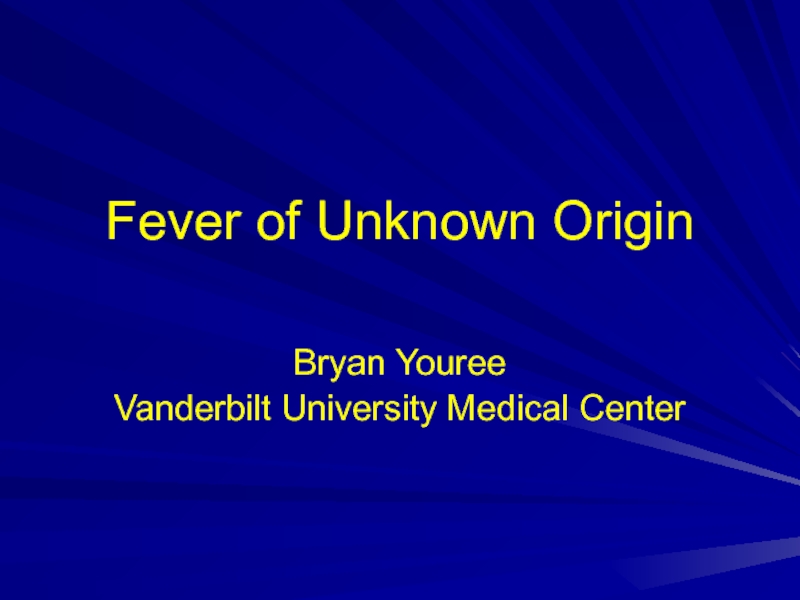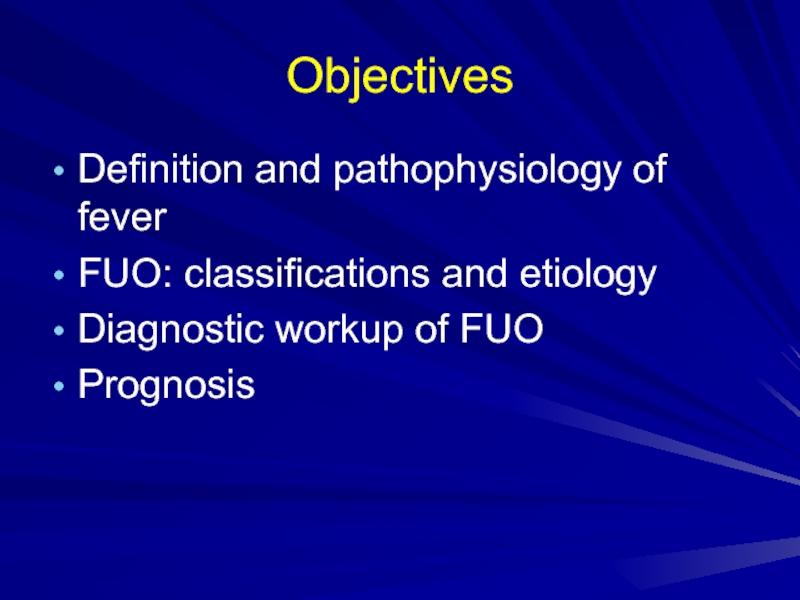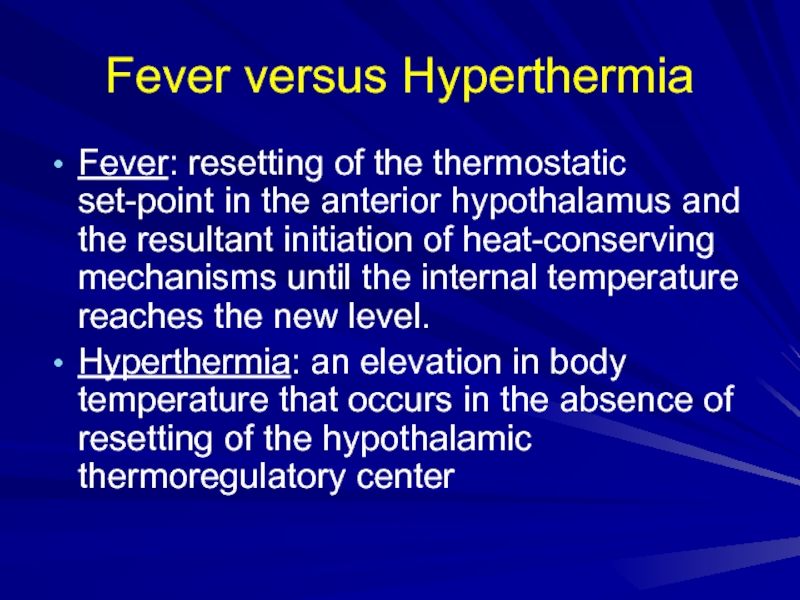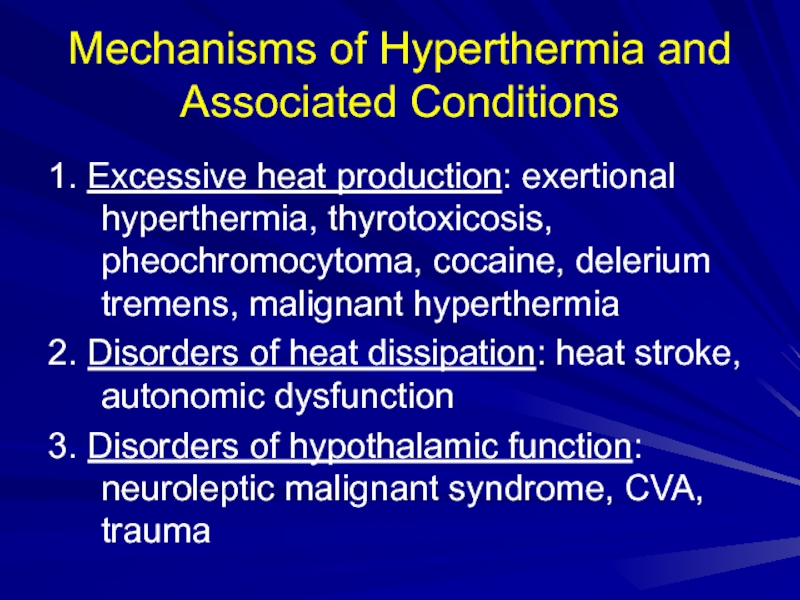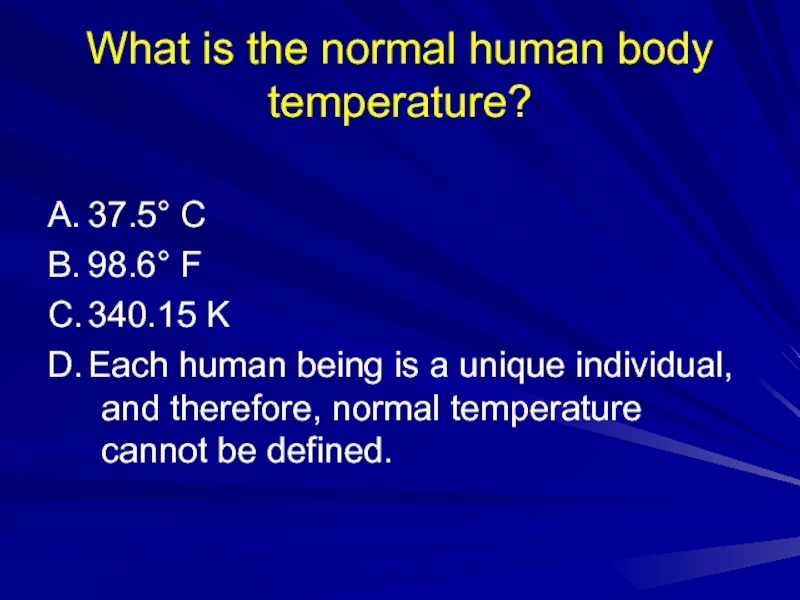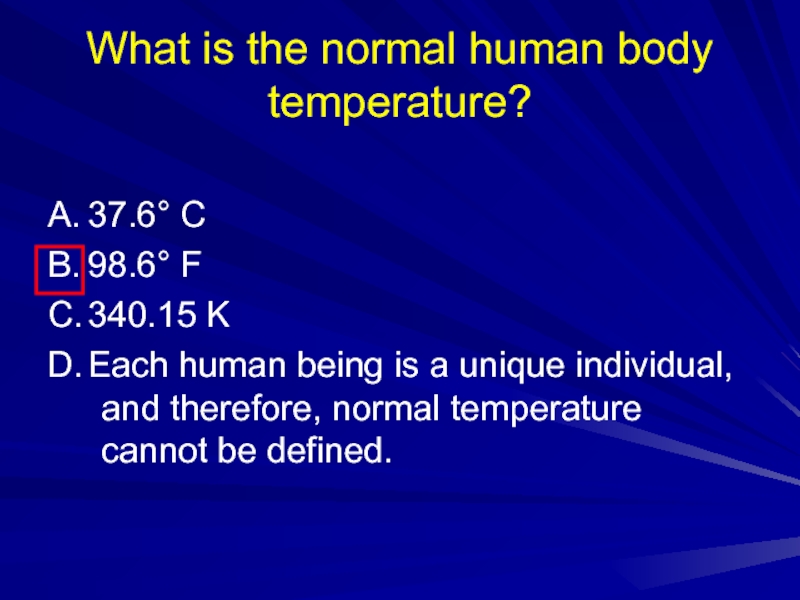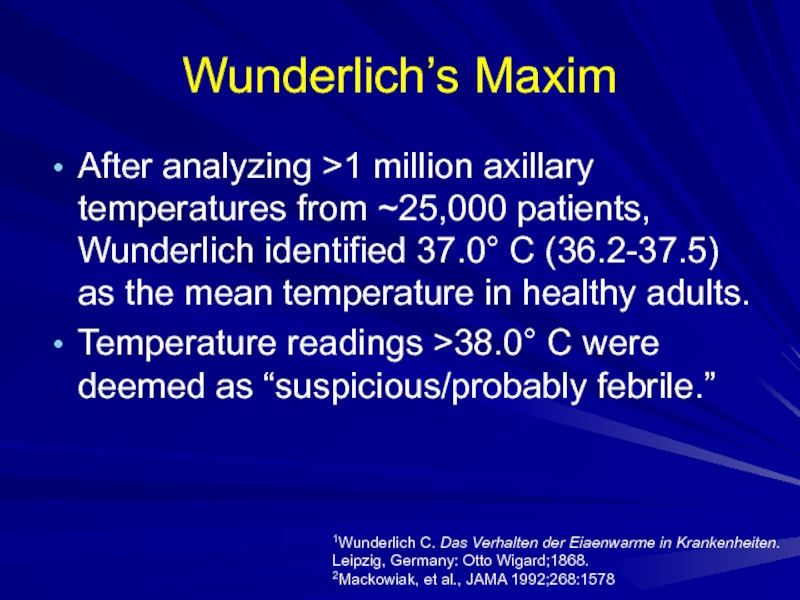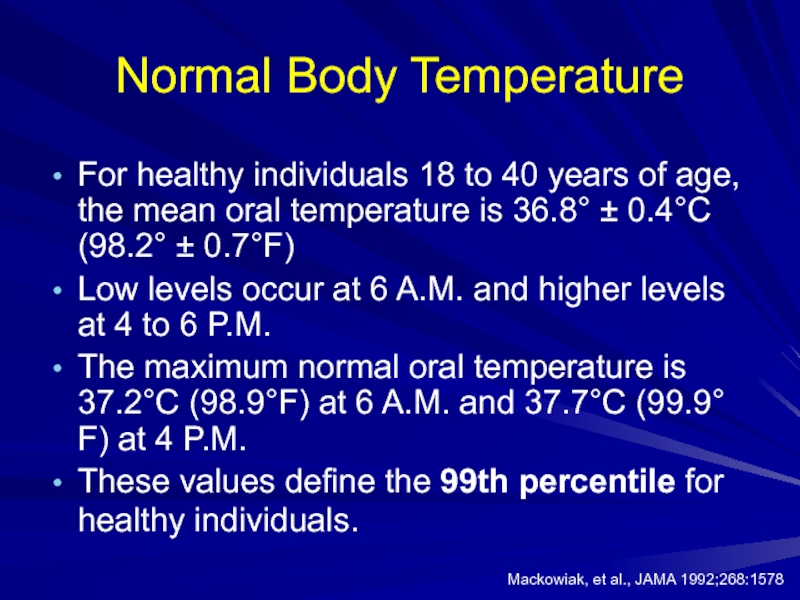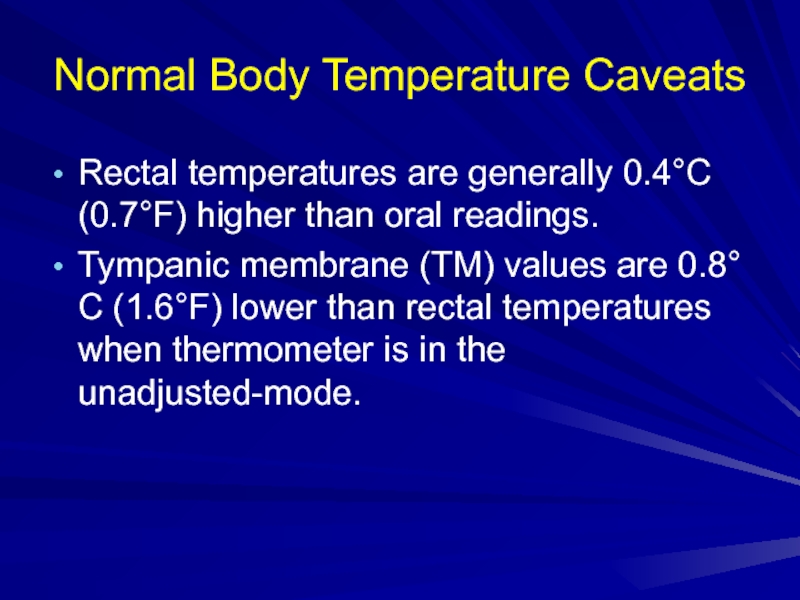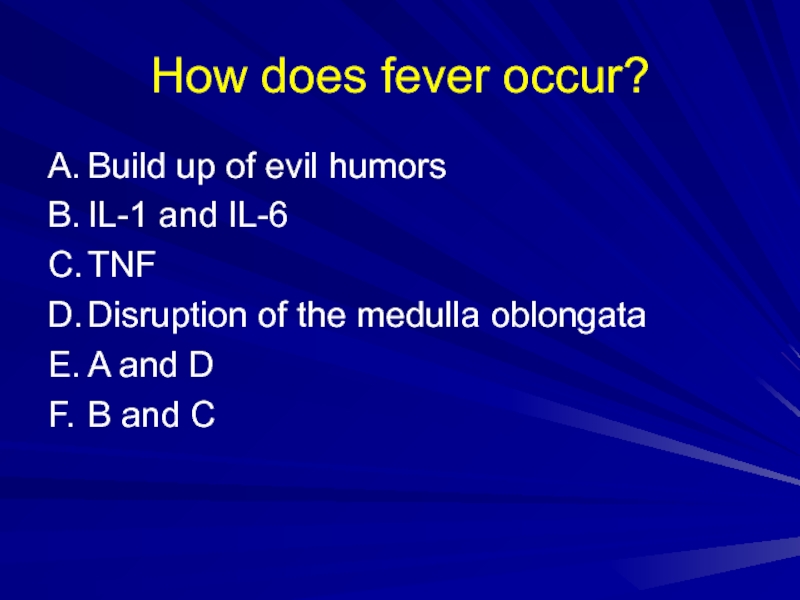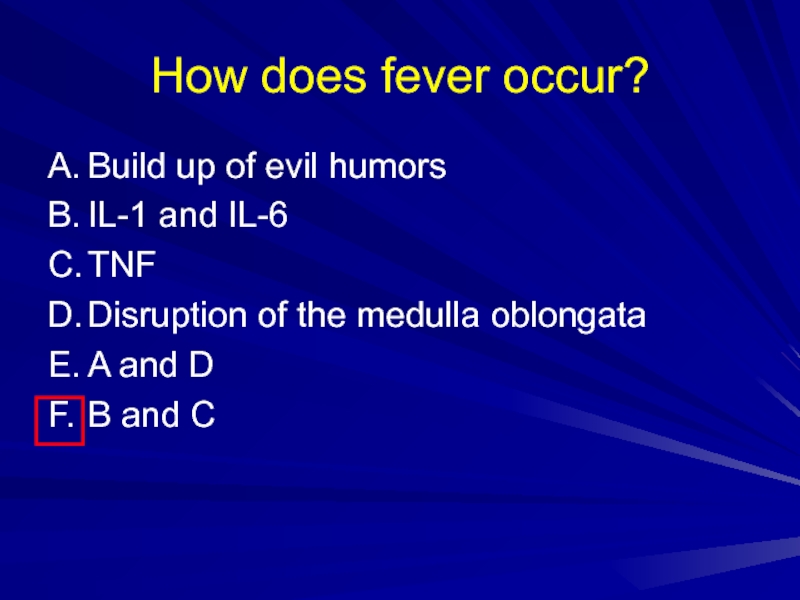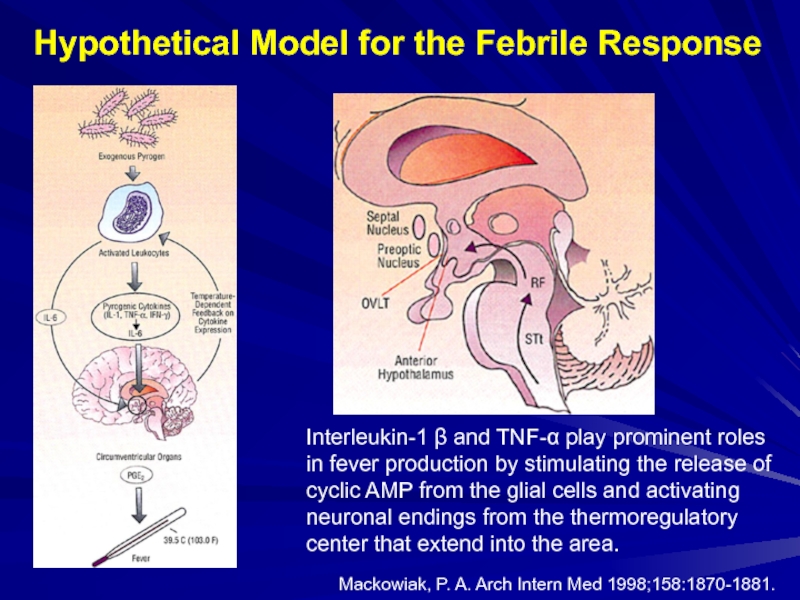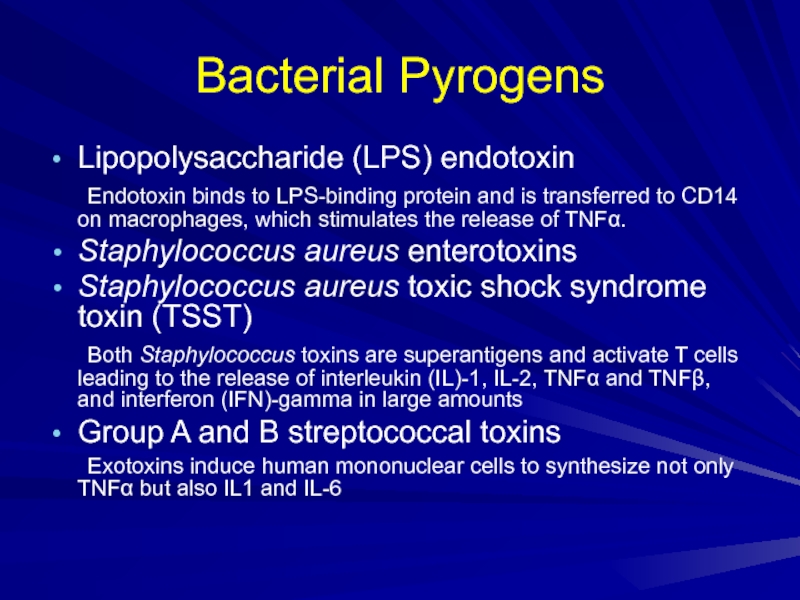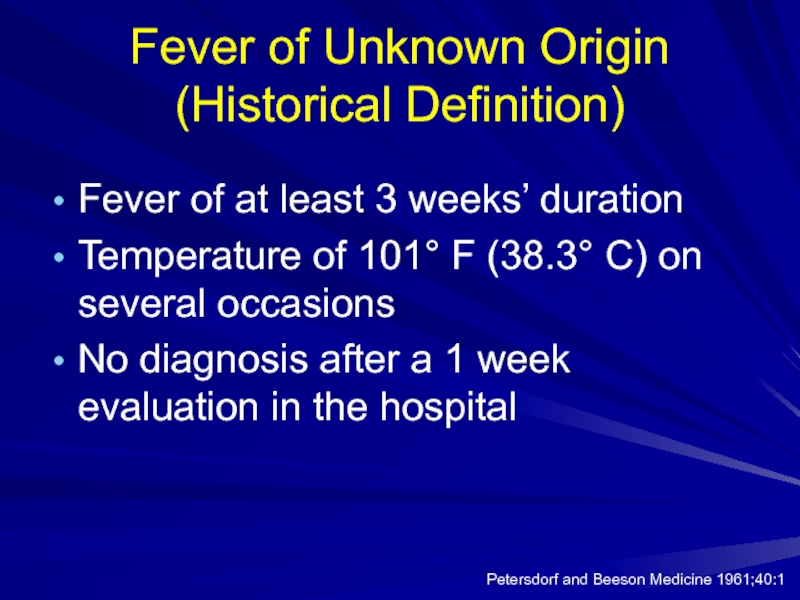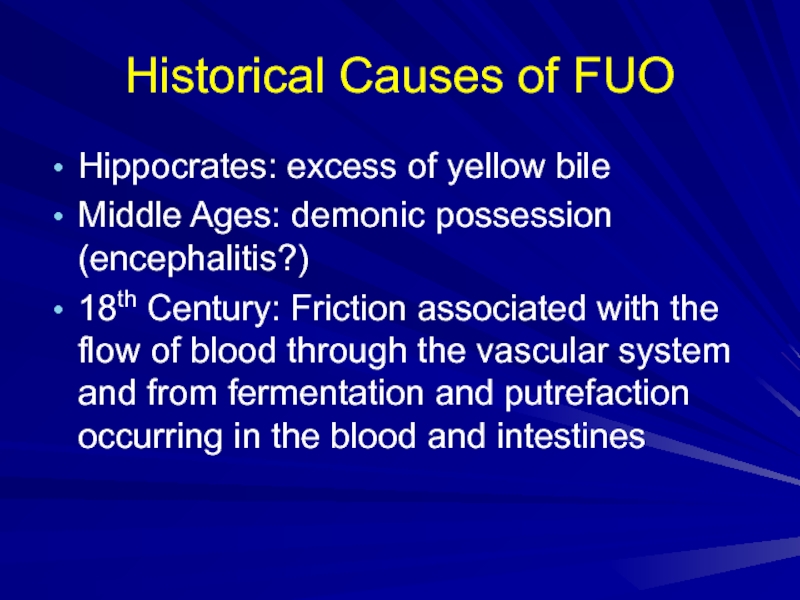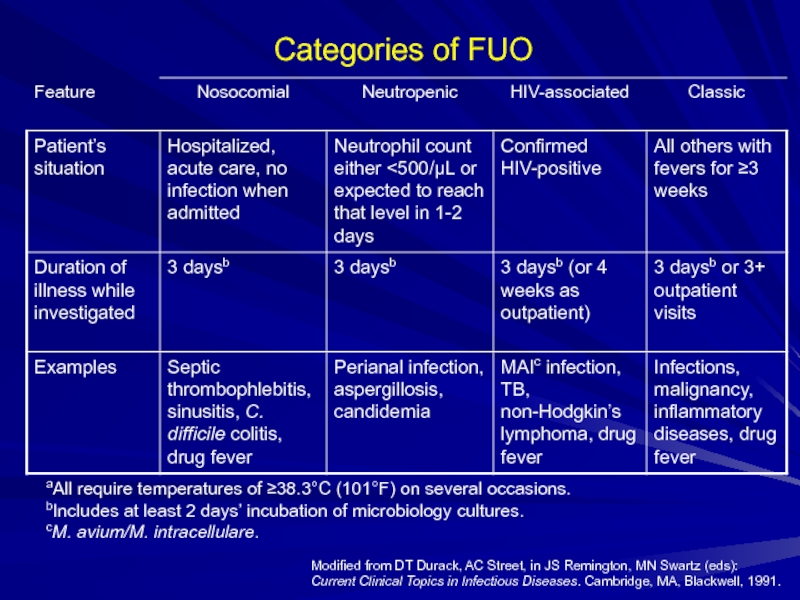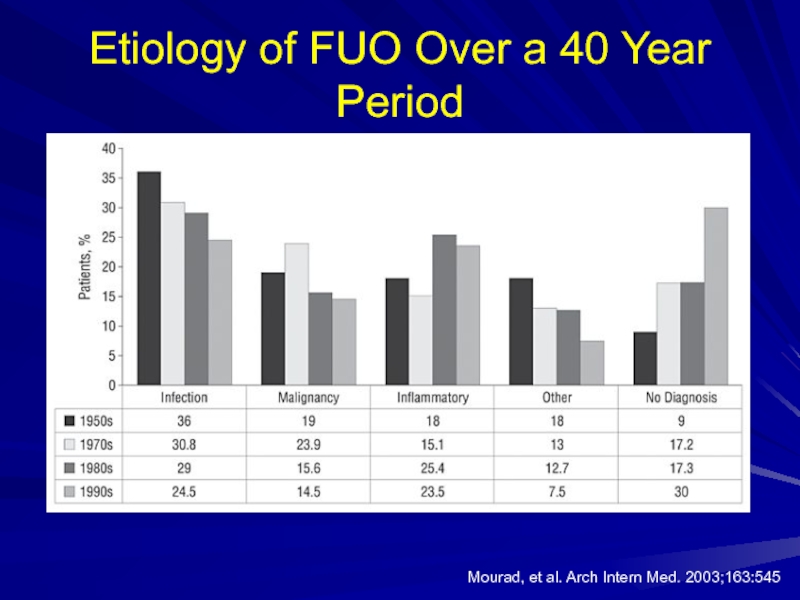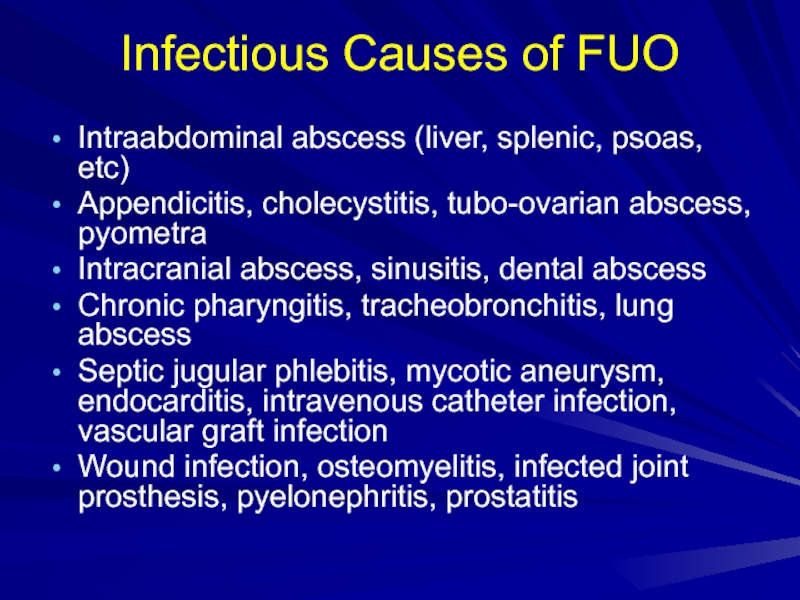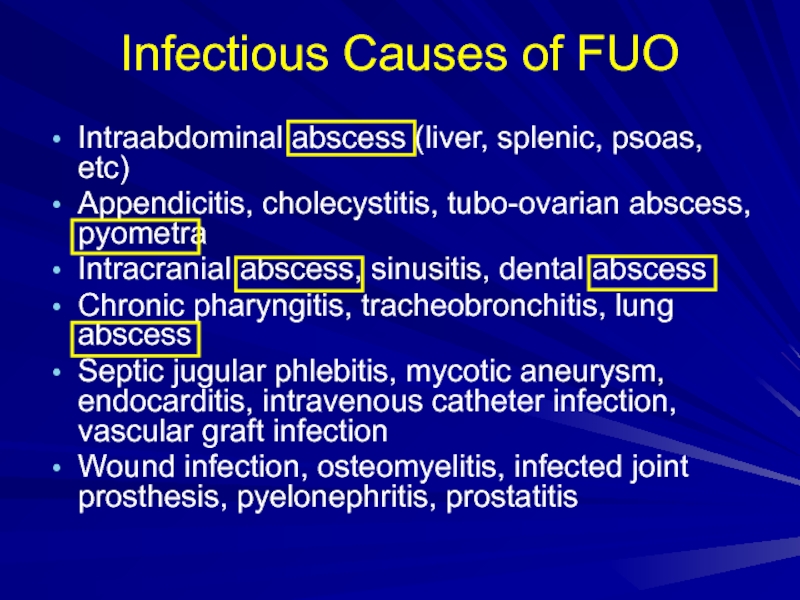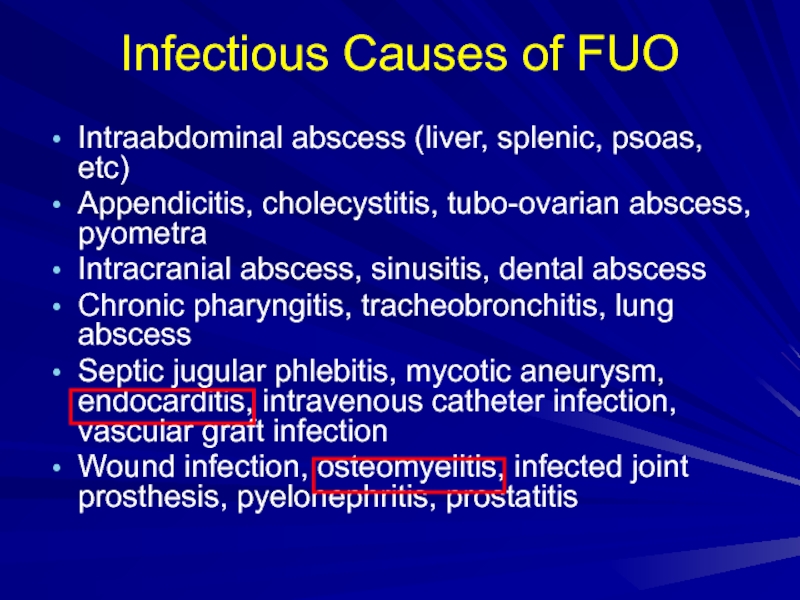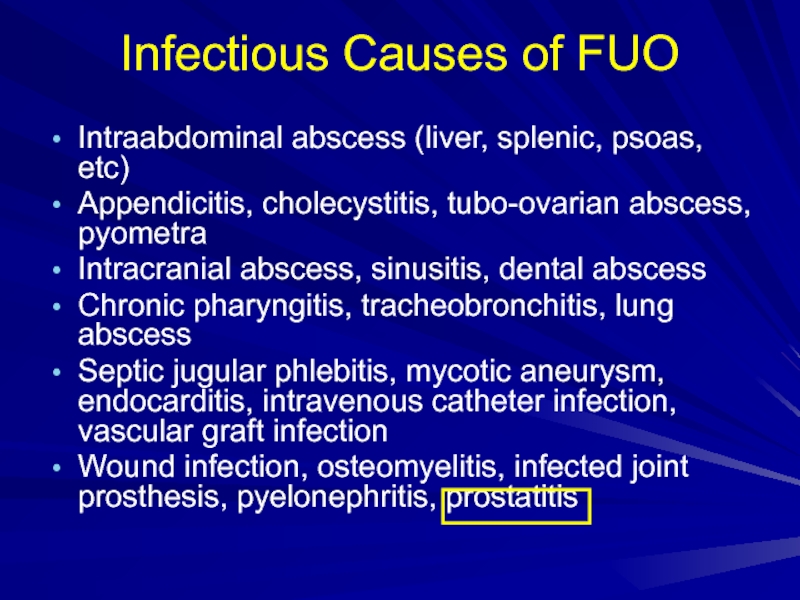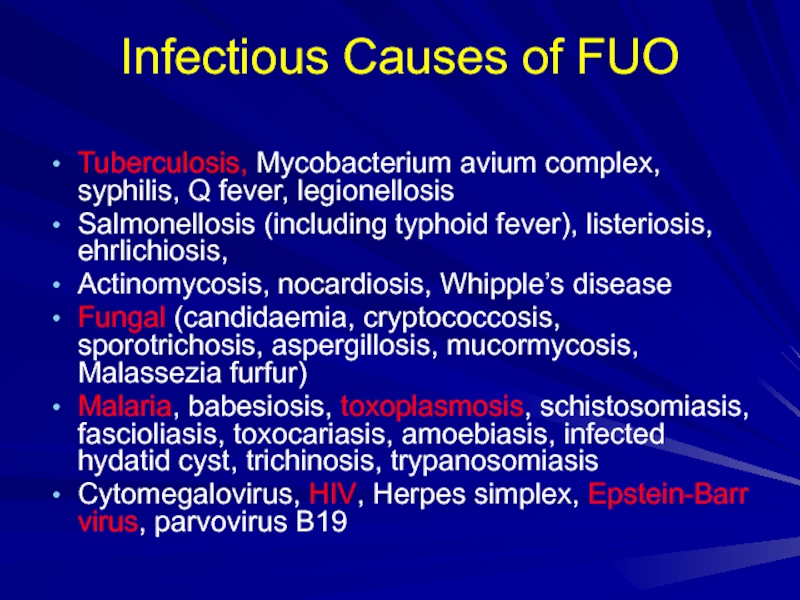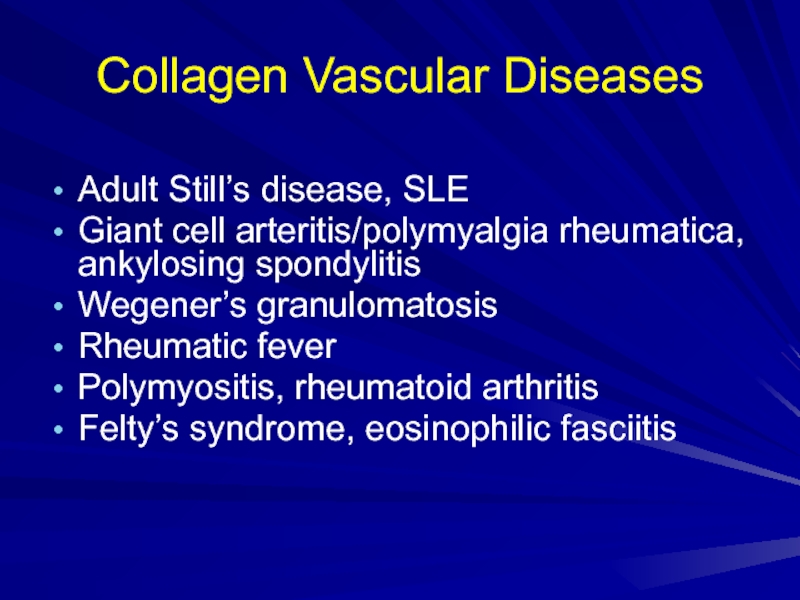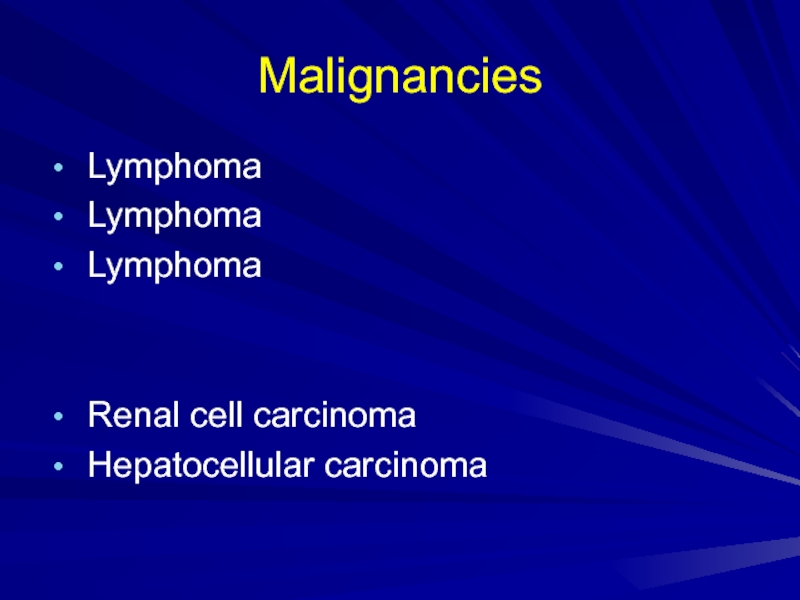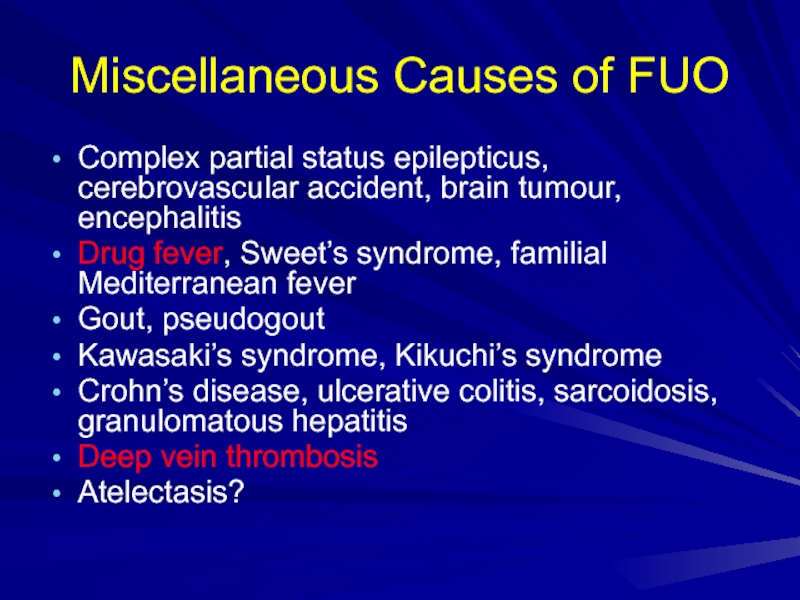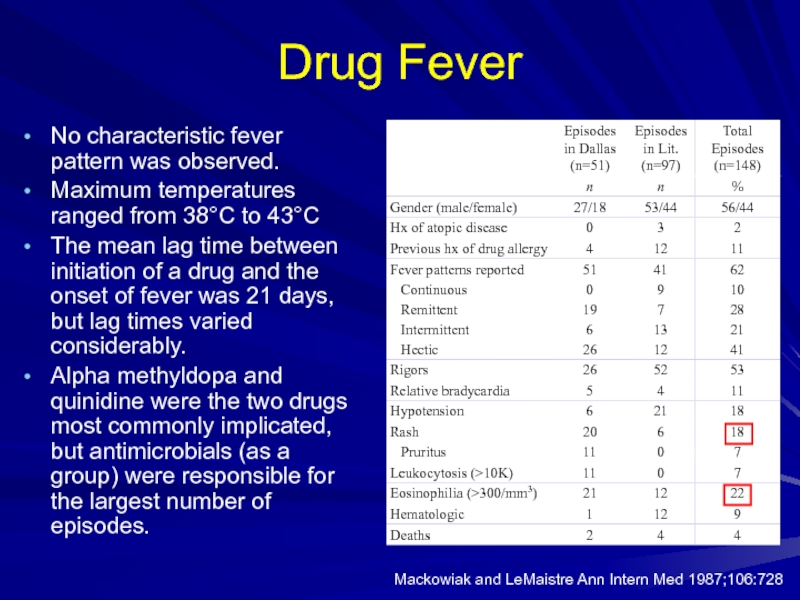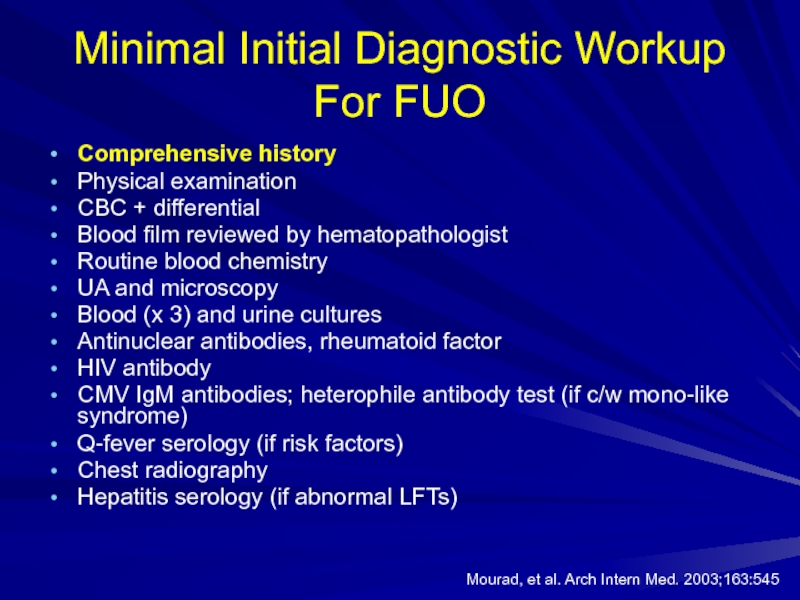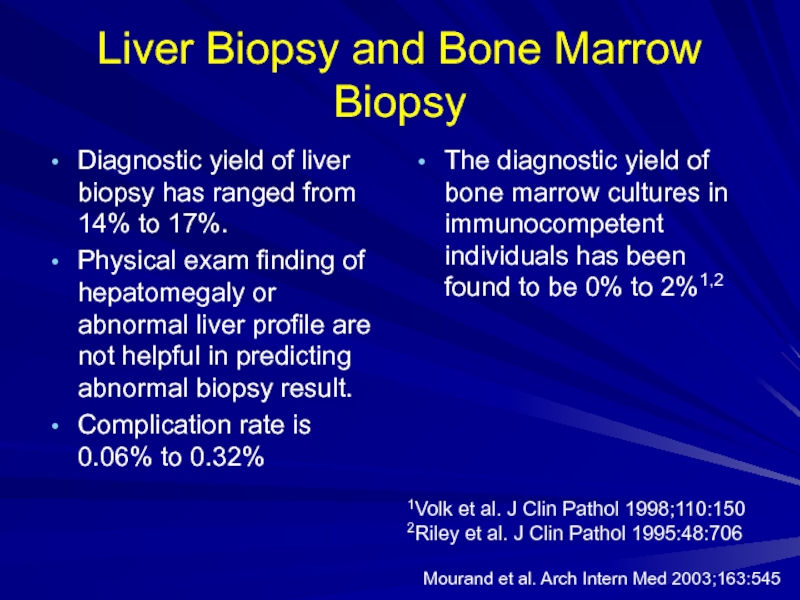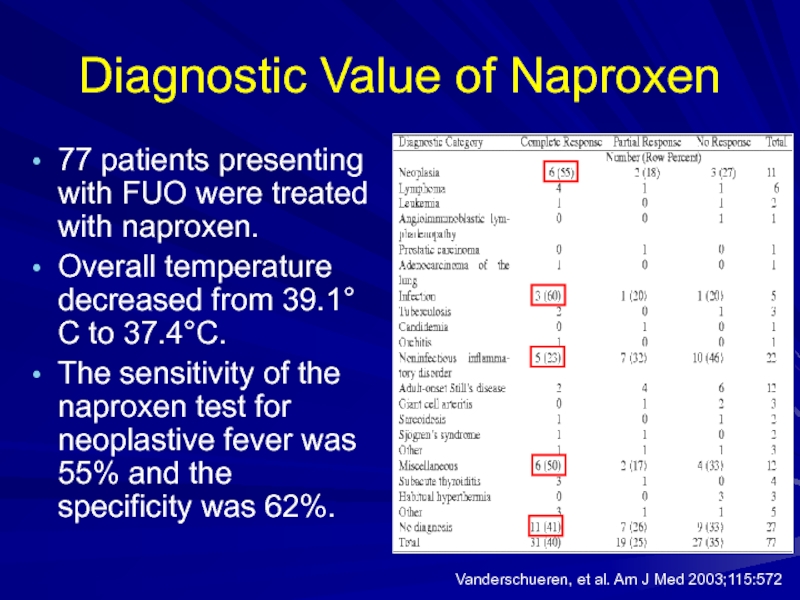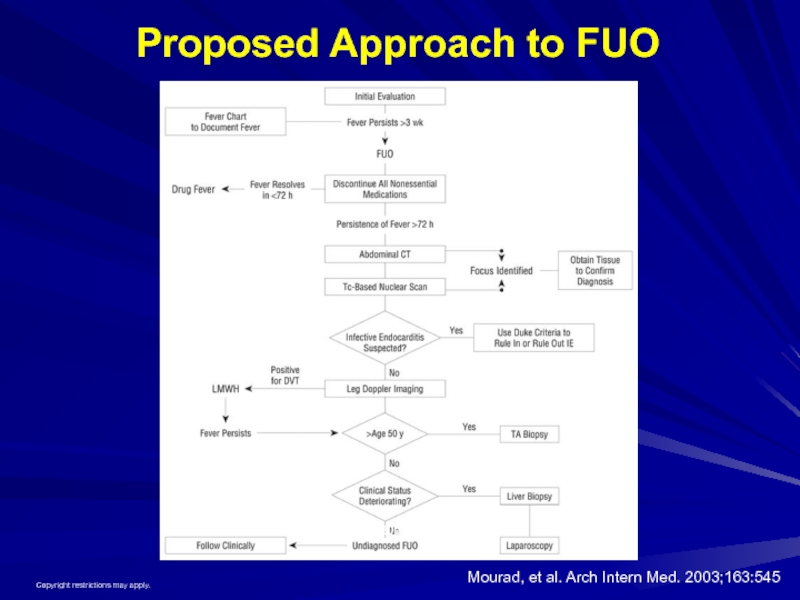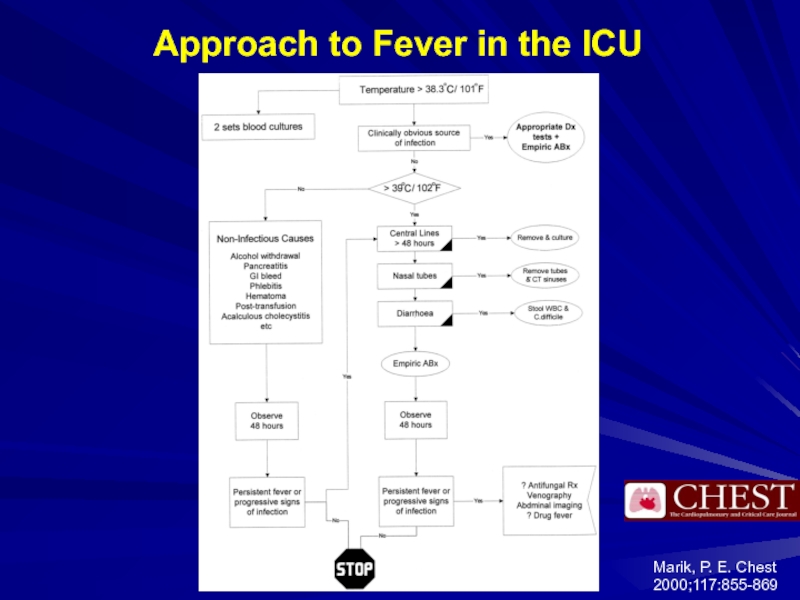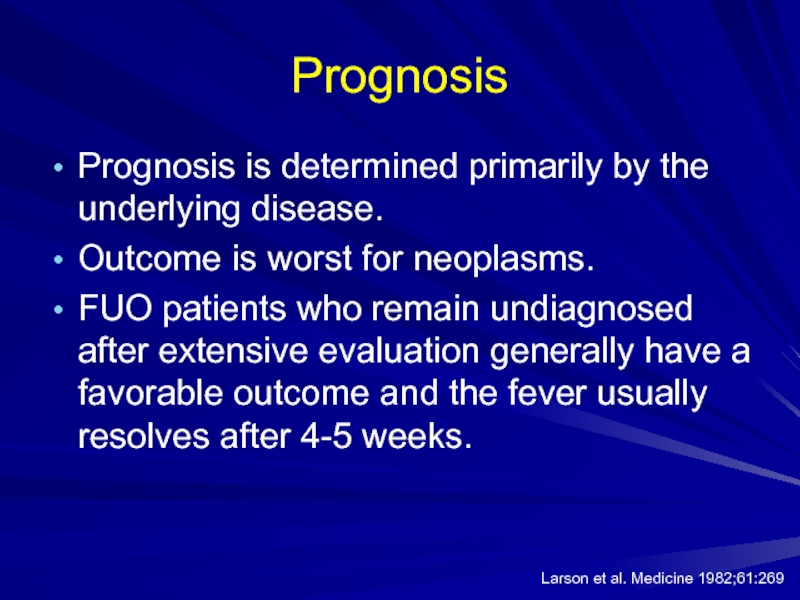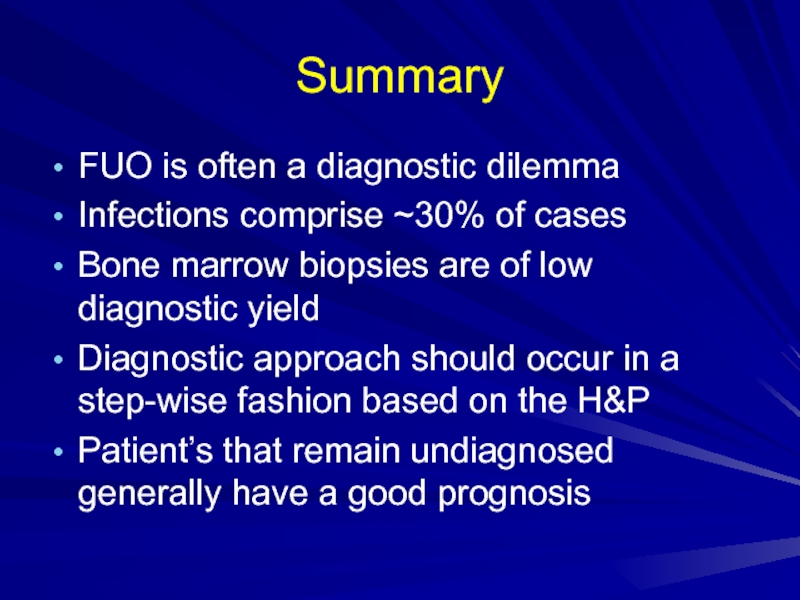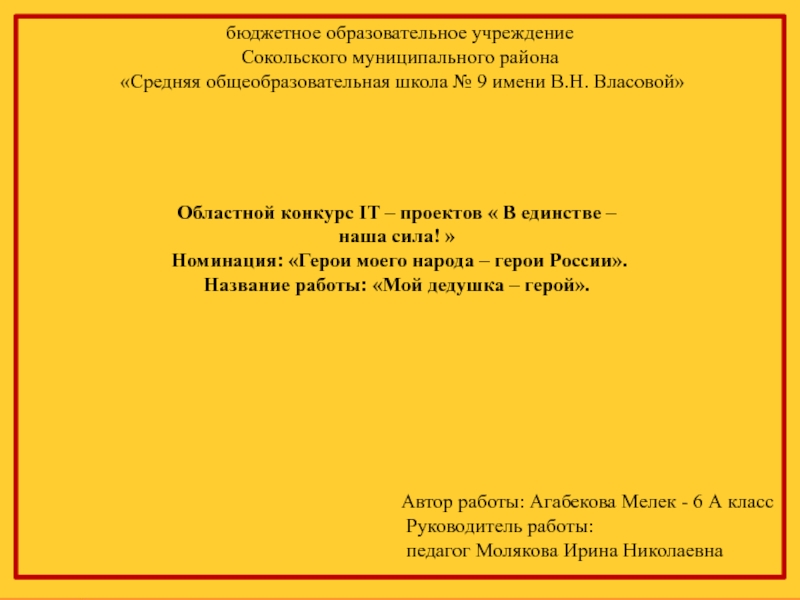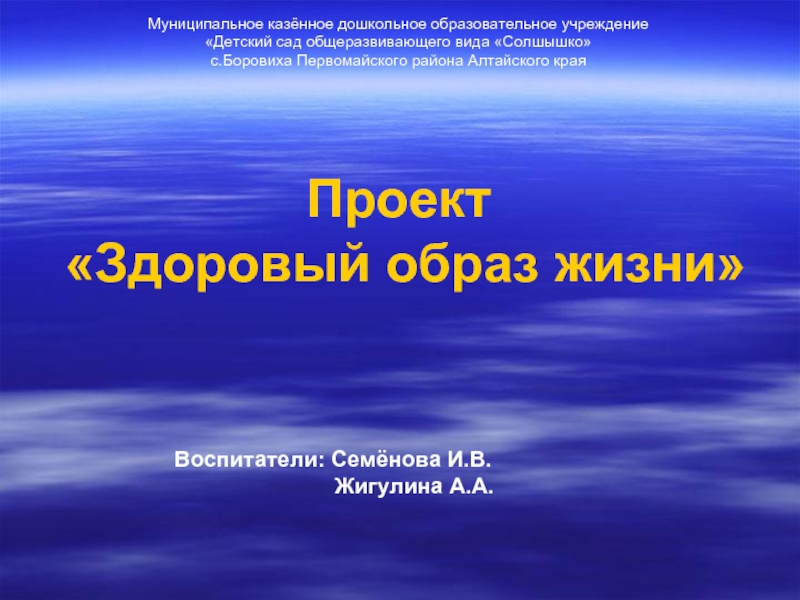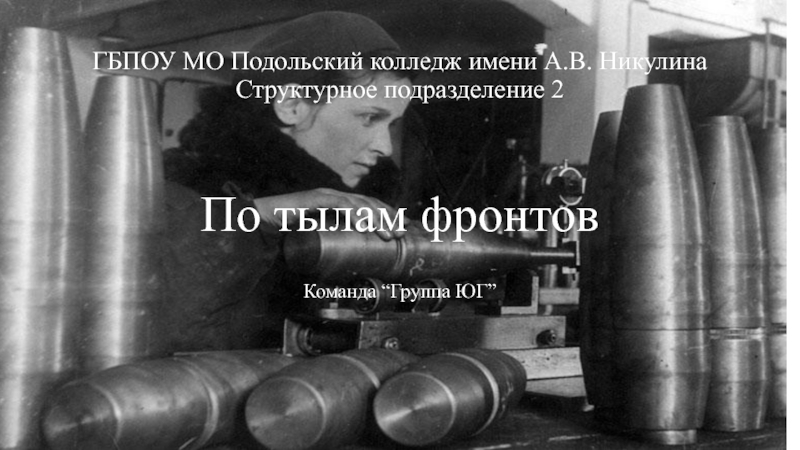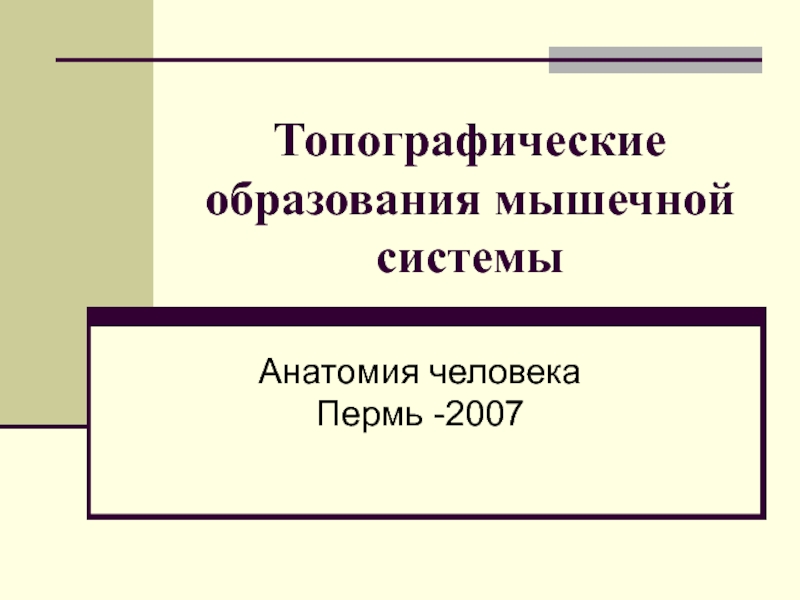Разделы презентаций
- Разное
- Английский язык
- Астрономия
- Алгебра
- Биология
- География
- Геометрия
- Детские презентации
- Информатика
- История
- Литература
- Математика
- Медицина
- Менеджмент
- Музыка
- МХК
- Немецкий язык
- ОБЖ
- Обществознание
- Окружающий мир
- Педагогика
- Русский язык
- Технология
- Физика
- Философия
- Химия
- Шаблоны, картинки для презентаций
- Экология
- Экономика
- Юриспруденция
Fever of Unknown Origin
Содержание
- 1. Fever of Unknown Origin
- 2. ObjectivesDefinition and pathophysiology of feverFUO: classifications and etiologyDiagnostic workup of FUOPrognosis
- 3. Fever versus HyperthermiaFever: resetting of the thermostatic
- 4. Mechanisms of Hyperthermia and Associated Conditions1. Excessive
- 5. What is the normal human body temperature?A. 37.5°
- 6. What is the normal human body temperature?A. 37.6°
- 7. Wunderlich’s MaximAfter analyzing >1 million axillary temperatures
- 8. Normal Body TemperatureFor healthy individuals 18 to
- 9. Normal Body Temperature CaveatsRectal temperatures are generally
- 10. How does fever occur?A. Build up of evil
- 11. How does fever occur?A. Build up of evil
- 12. Mackowiak, P. A. Arch Intern Med 1998;158:1870-1881.Hypothetical
- 13. Bacterial PyrogensLipopolysaccharide (LPS) endotoxin Endotoxin binds to LPS-binding
- 14. Fever of Unknown Origin (Historical Definition)Fever of
- 15. Historical Causes of FUOHippocrates: excess of yellow
- 16. aAll require temperatures of ≥38.3°C (101°F) on
- 17. Etiology of FUO Over a 40 Year PeriodMourad, et al. Arch Intern Med. 2003;163:545
- 18. Infectious Causes of FUOIntraabdominal abscess (liver, splenic,
- 19. Infectious Causes of FUOIntraabdominal abscess (liver, splenic,
- 20. Infectious Causes of FUOIntraabdominal abscess (liver, splenic,
- 21. Infectious Causes of FUOIntraabdominal abscess (liver, splenic,
- 22. Infectious Causes of FUOTuberculosis, Mycobacterium avium complex,
- 23. Collagen Vascular DiseasesAdult Still’s disease, SLEGiant cell
- 24. Malignancies Lymphoma Lymphoma Lymphoma Renal cell carcinoma Hepatocellular carcinoma
- 25. Miscellaneous Causes of FUOComplex partial status epilepticus,
- 26. Drug FeverNo characteristic fever pattern was observed.Maximum
- 27. Minimal Initial Diagnostic Workup For FUOComprehensive historyPhysical
- 28. Liver Biopsy and Bone Marrow BiopsyDiagnostic yield
- 29. Diagnostic Value of Naproxen77 patients presenting with
- 30. Copyright restrictions may apply.Mourad, O. et al.
- 31. Marik, P. E. Chest 2000;117:855-869Approach to Fever in the ICU
- 32. PrognosisPrognosis is determined primarily by the underlying
- 33. SummaryFUO is often a diagnostic dilemmaInfections comprise
- 34. Скачать презентанцию
Слайды и текст этой презентации
Слайд 2Objectives
Definition and pathophysiology of fever
FUO: classifications and etiology
Diagnostic workup of
FUO
Слайд 3Fever versus Hyperthermia
Fever: resetting of the thermostatic set-point in the
anterior hypothalamus and the resultant initiation of heat-conserving mechanisms until
the internal temperature reaches the new level.Hyperthermia: an elevation in body temperature that occurs in the absence of resetting of the hypothalamic thermoregulatory center
Слайд 4Mechanisms of Hyperthermia and Associated Conditions
1. Excessive heat production: exertional
hyperthermia, thyrotoxicosis, pheochromocytoma, cocaine, delerium tremens, malignant hyperthermia
2. Disorders of heat
dissipation: heat stroke, autonomic dysfunction3. Disorders of hypothalamic function: neuroleptic malignant syndrome, CVA, trauma
Слайд 5What is the normal human body temperature?
A. 37.5° C
B. 98.6° F
C. 340.15 K
D. Each
human being is a unique individual, and therefore, normal temperature
cannot be defined.Слайд 6What is the normal human body temperature?
A. 37.6° C
B. 98.6° F
C. 340.15 K
D. Each
human being is a unique individual, and therefore, normal temperature
cannot be defined.Слайд 7Wunderlich’s Maxim
After analyzing >1 million axillary temperatures from ~25,000 patients,
Wunderlich identified 37.0° C (36.2-37.5) as the mean temperature in
healthy adults.Temperature readings >38.0° C were deemed as “suspicious/probably febrile.”
1Wunderlich C. Das Verhalten der Eiaenwarme in Krankenheiten.
Leipzig, Germany: Otto Wigard;1868.
2Mackowiak, et al., JAMA 1992;268:1578
Слайд 8Normal Body Temperature
For healthy individuals 18 to 40 years of
age, the mean oral temperature is 36.8° ± 0.4°C (98.2°
± 0.7°F)Low levels occur at 6 A.M. and higher levels at 4 to 6 P.M.
The maximum normal oral temperature is 37.2°C (98.9°F) at 6 A.M. and 37.7°C (99.9°F) at 4 P.M.
These values define the 99th percentile for healthy individuals.
Mackowiak, et al., JAMA 1992;268:1578
Слайд 9Normal Body Temperature Caveats
Rectal temperatures are generally 0.4°C (0.7°F) higher
than oral readings.
Tympanic membrane (TM) values are 0.8°C (1.6°F)
lower than rectal temperatures when thermometer is in the unadjusted-mode. Слайд 10How does fever occur?
A. Build up of evil humors
B. IL-1 and IL-6
C. TNF
D. Disruption
of the medulla oblongata
E. A and D
F. B and C
Слайд 11How does fever occur?
A. Build up of evil humors
B. IL-1 and IL-6
C. TNF
D. Disruption
of the medulla oblongata
E. A and D
F. B and C
Слайд 12Mackowiak, P. A. Arch Intern Med 1998;158:1870-1881.
Hypothetical Model for the
Febrile Response
Interleukin-1 β and TNF-α play prominent roles
in fever production
by stimulating the release ofcyclic AMP from the glial cells and activating
neuronal endings from the thermoregulatory
center that extend into the area.
Слайд 13Bacterial Pyrogens
Lipopolysaccharide (LPS) endotoxin
Endotoxin binds to LPS-binding protein and is
transferred to CD14 on macrophages, which stimulates the release of
TNFα.Staphylococcus aureus enterotoxins
Staphylococcus aureus toxic shock syndrome toxin (TSST)
Both Staphylococcus toxins are superantigens and activate T cells leading to the release of interleukin (IL)-1, IL-2, TNFα and TNFβ, and interferon (IFN)-gamma in large amounts
Group A and B streptococcal toxins
Exotoxins induce human mononuclear cells to synthesize not only TNFα but also IL1 and IL-6
Слайд 14Fever of Unknown Origin
(Historical Definition)
Fever of at least 3 weeks’
duration
Temperature of 101° F (38.3° C) on several occasions
No diagnosis
after a 1 week evaluation in the hospitalPetersdorf and Beeson Medicine 1961;40:1
Слайд 15Historical Causes of FUO
Hippocrates: excess of yellow bile
Middle Ages: demonic
possession (encephalitis?)
18th Century: Friction associated with the flow of blood
through the vascular system and from fermentation and putrefaction occurring in the blood and intestinesСлайд 16aAll require temperatures of ≥38.3°C (101°F) on several occasions.
bIncludes at
least 2 days’ incubation of microbiology cultures.
cM. avium/M. intracellulare.
Modified from
DT Durack, AC Street, in JS Remington, MN Swartz (eds): Current Clinical Topics in Infectious Diseases. Cambridge, MA, Blackwell, 1991.
Слайд 18Infectious Causes of FUO
Intraabdominal abscess (liver, splenic, psoas, etc)
Appendicitis, cholecystitis,
tubo-ovarian abscess, pyometra
Intracranial abscess, sinusitis, dental abscess
Chronic pharyngitis, tracheobronchitis, lung
abscessSeptic jugular phlebitis, mycotic aneurysm, endocarditis, intravenous catheter infection, vascular graft infection
Wound infection, osteomyelitis, infected joint prosthesis, pyelonephritis, prostatitis
Слайд 19Infectious Causes of FUO
Intraabdominal abscess (liver, splenic, psoas, etc)
Appendicitis, cholecystitis,
tubo-ovarian abscess, pyometra
Intracranial abscess, sinusitis, dental abscess
Chronic pharyngitis, tracheobronchitis, lung
abscessSeptic jugular phlebitis, mycotic aneurysm, endocarditis, intravenous catheter infection, vascular graft infection
Wound infection, osteomyelitis, infected joint prosthesis, pyelonephritis, prostatitis
Слайд 20Infectious Causes of FUO
Intraabdominal abscess (liver, splenic, psoas, etc)
Appendicitis, cholecystitis,
tubo-ovarian abscess, pyometra
Intracranial abscess, sinusitis, dental abscess
Chronic pharyngitis, tracheobronchitis, lung
abscessSeptic jugular phlebitis, mycotic aneurysm, endocarditis, intravenous catheter infection, vascular graft infection
Wound infection, osteomyelitis, infected joint prosthesis, pyelonephritis, prostatitis
Слайд 21Infectious Causes of FUO
Intraabdominal abscess (liver, splenic, psoas, etc)
Appendicitis, cholecystitis,
tubo-ovarian abscess, pyometra
Intracranial abscess, sinusitis, dental abscess
Chronic pharyngitis, tracheobronchitis, lung
abscessSeptic jugular phlebitis, mycotic aneurysm, endocarditis, intravenous catheter infection, vascular graft infection
Wound infection, osteomyelitis, infected joint prosthesis, pyelonephritis, prostatitis
Слайд 22Infectious Causes of FUO
Tuberculosis, Mycobacterium avium complex, syphilis, Q fever,
legionellosis
Salmonellosis (including typhoid fever), listeriosis, ehrlichiosis,
Actinomycosis, nocardiosis, Whipple’s disease
Fungal
(candidaemia, cryptococcosis, sporotrichosis, aspergillosis, mucormycosis, Malassezia furfur)Malaria, babesiosis, toxoplasmosis, schistosomiasis, fascioliasis, toxocariasis, amoebiasis, infected hydatid cyst, trichinosis, trypanosomiasis
Cytomegalovirus, HIV, Herpes simplex, Epstein-Barr virus, parvovirus B19
Слайд 23Collagen Vascular Diseases
Adult Still’s disease, SLE
Giant cell arteritis/polymyalgia rheumatica, ankylosing
spondylitis
Wegener’s granulomatosis
Rheumatic fever
Polymyositis, rheumatoid arthritis
Felty’s syndrome, eosinophilic fasciitis
Слайд 25Miscellaneous Causes of FUO
Complex partial status epilepticus, cerebrovascular accident, brain
tumour, encephalitis
Drug fever, Sweet’s syndrome, familial Mediterranean fever
Gout, pseudogout
Kawasaki’s syndrome,
Kikuchi’s syndromeCrohn’s disease, ulcerative colitis, sarcoidosis, granulomatous hepatitis
Deep vein thrombosis
Atelectasis?
Слайд 26Drug Fever
No characteristic fever pattern was observed.
Maximum temperatures ranged from
38°C to 43°C
The mean lag time between initiation of a
drug and the onset of fever was 21 days, but lag times varied considerably.Alpha methyldopa and quinidine were the two drugs most commonly implicated, but antimicrobials (as a group) were responsible for the largest number of episodes.
Mackowiak and LeMaistre Ann Intern Med 1987;106:728
Слайд 27Minimal Initial Diagnostic Workup For FUO
Comprehensive history
Physical examination
CBC + differential
Blood
film reviewed by hematopathologist
Routine blood chemistry
UA and microscopy
Blood (x 3)
and urine culturesAntinuclear antibodies, rheumatoid factor
HIV antibody
CMV IgM antibodies; heterophile antibody test (if c/w mono-like syndrome)
Q-fever serology (if risk factors)
Chest radiography
Hepatitis serology (if abnormal LFTs)
Mourad, et al. Arch Intern Med. 2003;163:545
Слайд 28Liver Biopsy and Bone Marrow Biopsy
Diagnostic yield of liver biopsy
has ranged from 14% to 17%.
Physical exam finding of hepatomegaly
or abnormal liver profile are not helpful in predicting abnormal biopsy result.Complication rate is 0.06% to 0.32%
The diagnostic yield of bone marrow cultures in immunocompetent individuals has been found to be 0% to 2%1,2
Mourand et al. Arch Intern Med 2003;163:545
1Volk et al. J Clin Pathol 1998;110:150
2Riley et al. J Clin Pathol 1995:48:706
Слайд 29Diagnostic Value of Naproxen
77 patients presenting with FUO were treated
with naproxen.
Overall temperature decreased from 39.1°C to 37.4°C.
The sensitivity of
the naproxen test for neoplastive fever was 55% and the specificity was 62%.Vanderschueren, et al. Am J Med 2003;115:572
Слайд 30Copyright restrictions may apply.
Mourad, O. et al. Arch Intern Med
2003;163:545-551.
Proposed Approach to FUO
Mourad, et al. Arch Intern Med. 2003;163:545
Слайд 32Prognosis
Prognosis is determined primarily by the underlying disease.
Outcome is worst
for neoplasms.
FUO patients who remain undiagnosed after extensive evaluation generally
have a favorable outcome and the fever usually resolves after 4-5 weeks.Larson et al. Medicine 1982;61:269
Слайд 33Summary
FUO is often a diagnostic dilemma
Infections comprise ~30% of cases
Bone
marrow biopsies are of low diagnostic yield
Diagnostic approach should occur
in a step-wise fashion based on the H&PPatient’s that remain undiagnosed generally have a good prognosis
